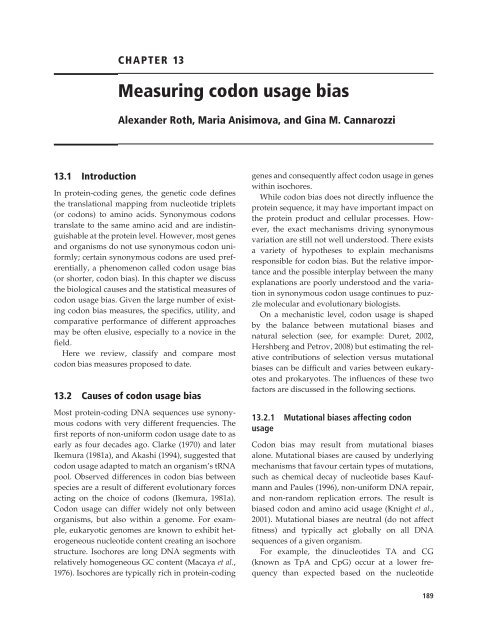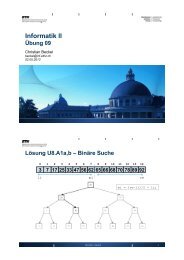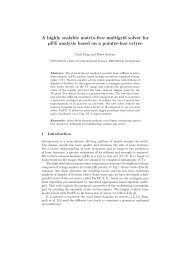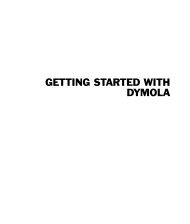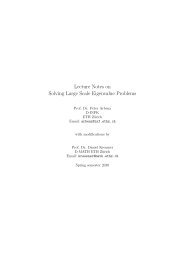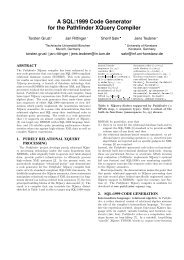Codon Evolution Mechanisms and Models
Codon Evolution Mechanisms and Models
Codon Evolution Mechanisms and Models
Create successful ePaper yourself
Turn your PDF publications into a flip-book with our unique Google optimized e-Paper software.
13.1 Introduction<br />
CHAPTER 13<br />
Measuring codon usage bias<br />
Alex<strong>and</strong>er Roth, Maria Anisimova, <strong>and</strong> Gina M. Cannarozzi<br />
In protein-coding genes, the genetic code defines<br />
the translational mapping from nucleotide triplets<br />
(or codons) to amino acids. Synonymous codons<br />
translate to the same amino acid <strong>and</strong> are indistinguishable<br />
at the protein level. However, most genes<br />
<strong>and</strong> organisms do not use synonymous codon uniformly;<br />
certain synonymous codons are used preferentially,<br />
a phenomenon called codon usage bias<br />
(or shorter, codon bias). In this chapter we discuss<br />
the biological causes <strong>and</strong> the statistical measures of<br />
codon usage bias. Given the large number of existing<br />
codon bias measures, the specifics, utility, <strong>and</strong><br />
comparative performance of different approaches<br />
may be often elusive, especially to a novice in the<br />
field.<br />
Here we review, classify <strong>and</strong> compare most<br />
codon bias measures proposed to date.<br />
13.2 Causes of codon usage bias<br />
Most protein-coding DNA sequences use synonymous<br />
codons with very different frequencies. The<br />
first reports of non-uniform codon usage date to as<br />
early as four decades ago. Clarke (1970) <strong>and</strong> later<br />
Ikemura (1981a), <strong>and</strong> Akashi (1994), suggested that<br />
codon usage adapted to match an organism’s tRNA<br />
pool. Observed differences in codon bias between<br />
species are a result of different evolutionary forces<br />
acting on the choice of codons (Ikemura, 1981a).<br />
<strong>Codon</strong> usage can differ widely not only between<br />
organisms, but also within a genome. For example,<br />
eukaryotic genomes are known to exhibit heterogeneous<br />
nucleotide content creating an isochore<br />
structure. Isochores are long DNA segments with<br />
relatively homogeneous GC content (Macaya et al.,<br />
1976). Isochores are typically rich in protein-coding<br />
genes <strong>and</strong> consequently affect codon usage in genes<br />
within isochores.<br />
While codon bias does not directly influence the<br />
protein sequence, it may have important impact on<br />
the protein product <strong>and</strong> cellular processes. However,<br />
the exact mechanisms driving synonymous<br />
variation are still not well understood. There exists<br />
a variety of hypotheses to explain mechanisms<br />
responsible for codon bias. But the relative importance<br />
<strong>and</strong> the possible interplay between the many<br />
explanations are poorly understood <strong>and</strong> the variation<br />
in synonymous codon usage continues to puzzle<br />
molecular <strong>and</strong> evolutionary biologists.<br />
On a mechanistic level, codon usage is shaped<br />
by the balance between mutational biases <strong>and</strong><br />
natural selection (see, for example: Duret, 2002,<br />
Hershberg <strong>and</strong> Petrov, 2008) but estimating the relative<br />
contributions of selection versus mutational<br />
biases can be difficult <strong>and</strong> varies between eukaryotes<br />
<strong>and</strong> prokaryotes. The influences of these two<br />
factors are discussed in the following sections.<br />
13.2.1 Mutational biases affecting codon<br />
usage<br />
<strong>Codon</strong> bias may result from mutational biases<br />
alone. Mutational biases are caused by underlying<br />
mechanisms that favour certain types of mutations,<br />
such as chemical decay of nucleotide bases Kaufmann<br />
<strong>and</strong> Paules (1996), non-uniform DNA repair,<br />
<strong>and</strong> non-r<strong>and</strong>om replication errors. The result is<br />
biased codon <strong>and</strong> amino acid usage (Knight et al.,<br />
2001). Mutational biases are neutral (do not affect<br />
fitness) <strong>and</strong> typically act globally on all DNA<br />
sequences of a given organism.<br />
For example, the dinucleotides TA <strong>and</strong> CG<br />
(known as TpA <strong>and</strong> CpG) occur at a lower frequency<br />
than expected based on the nucleotide<br />
189


